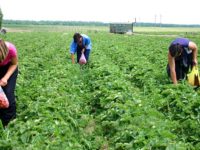Australian farmers are predicting that the combined factors of high commodity prices, low-interest rates and good seasonal conditions will continue in the year ahead – sustaining a continued high level of confidence across the sector.
According to the latest Q4 Rabobank Rural Confidence Survey, Australian farm sector confidence held strong over the latest quarter, albeit easing from the near-record levels reported in the last survey.
However, the impact of recent excessive rainfall and flooding in the southern Queensland and northern and central New South Wales grain-growing region has yet to be taken into account, as the rainfall occurred after the survey was conducted and may significantly alter previously-high income projections in the grain sector.
Production losses have not been as significant in the livestock sector though, which continues to enjoy sustained high commodity prices and favourable grazing conditions, while many summer croppers and cotton producers look set to capitalise on surety of water supplies and full soil moisture profiles.
The survey also noted that while overall national farmer confidence had softened on last quarter, it remained at still strong levels, with 84 per cent of Australian farmers saying the agricultural economy will continue to perform at, or exceed, its currently-positive levels in the year ahead.
The survey has also reported record-high levels of business viability, with the Farm Viability Index – measuring farmers’ assessments of their own business viability – sitting at the highest level in the survey’s history.
Rabobank Australia CEO Peter Knoblanche said strong demand for Australian commodities, good seasons and favourable business settings were supporting solid, long-term confidence, although this would likely be diminished among grain growers and other flood-affected producers heading into the end of the year.
“Overall, there is significant long-term positivity in Australia’s farm sector – we see it in the high levels of farm viability reported, in farmers’ strong investment plans, and in the optimism about the year ahead,” Knoblanche said. “But while above-average rainfall has been a blessing in some sectors, it has caused significant heartbreak in others.”
The latest survey found 35 per cent of farmers expecting conditions in the agricultural economy to improve over the year ahead, easing from 43 per cent with that view in the September quarter. A further 49 per cent reported they were expecting farm business conditions to remain stable over the coming 12 months, while 13 per cent expect conditions will worsen – an increase on the four per cent of farmers with that view last quarter.
Rising commodity prices continue to be the primary driver of positive outlook across all sectors, with 77 per cent of farmers expecting conditions to improve citing commodity pricing as the key reason. Favourable seasonal conditions were still also a cause for optimism, but less so this quarter – cited by 58 per cent of those expecting improved conditions (down from 70 per cent last quarter).
Knoblanche said that Rabobank’s Rural Commodity Price Index (comprising local prices for 10 agricultural commodities) eclipsed its previous November figures, with small drops in the price of sheepmeat, wool, and sorghum offset by increases for all other commodities, particularly canola, to set a new benchmark in the 12-year history of the index. The ongoing rise in input costs – particularly fertiliser and farm chemicals – was growing as a concern, however, and could be a significant challenge for the farm sector next year.
Rising input costs were the main issue nominated by farmers in the survey who were expecting conditions to deteriorate in the year ahead (cited by more than half). By comparison, four per cent attributed their pessimistic view to Covid-19 and four per cent to too much rain.
This story originally appeared in our sister publication, Inside Small Business.

















